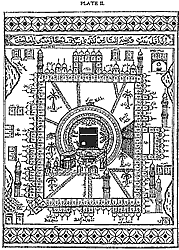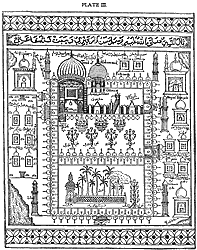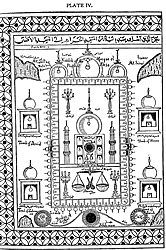
Plate I
(130 kB)
Source: S.W. Zwemer, Arabia: The Cradle of Islam, 3rd Edition, Fleming Revell
Co., 1900, facing p. 40.
PLATE I. has, at the right-hand upper corner,
the representation of the Mosque of Muzdalifa and tents of the Pilgrims; to the
left of this, the Mosque of Nimr, near Mount Arafat, and below it, the Mahmals
of Syria and Egypt, i.e., palaquins carried on camels, surmounted by flags. To
the right is Mount Arafat, a sacred mountain about 12 miles northeast of Mecca,
which, in Moslem tradition, is said to be the place where Adam and Eve met after
the fall. The three pillars of Mina represented below, are ancient pagan
shrines, at each of which every pilgrim must hurl seven stones at the devil.
Near this is pictured the Mesjed, or Mosque of Taif, the altar of Ishmael, the
Dome of Abd-el Kader in Bagdad, and at the extreme right the Dome of "Our Lord"
Hassein al Kerbela, where thousands of corpses of deceased Persians are brought
yearly to be buried. It is southwest of Bagdad, and lies in Turkish territory.
There are also pictured the birthplaces of Mohammed, Ali Ibu Abi Talb, Abu Bekr,
and Fatimeh, and the Tomb of Amina and Khadijah; also two bell-shaped hills,
Jebel Thaur and Jebel Nur. |

Plate II
(135 kB)
Source: S.W. Zwemer, Arabia: The Cradle of Islam, 3rd Edition, Fleming Revell
Co., 1900, facing p. 40. PLATE II. pictures the quadrangular court
of the Mecca Haram, within which is the circular colonnade, enclosing the Kaaba
or Beit Allah, the House of God. Below the representation of the Kaaba is
depicted the famous station of Abraham, a stone 20 inches long by 15 inches
wide. It is in the shape of a basin, and is buried in the earth. The name of
Abraham is connected with it from the tradition that he first built the Kaaba.
Below this may be noticed the famous "Beer Zemzem" or Well of Zemzem, which is
claimed to be the water which Hagar saw, when Ishmael was dying of thrist.
Around the circle are the praying places of the Malikis, the Hanafys, the
Hanbalys and the Shafi-is, the four great sects of Islam. Around the quadrangle
are 20 gates, such as Bab-su-Nebi, Gate of the Prophet, Gate of Abraham, of
Peace, of Abbas, of the Mare, the Mule, Safa, of Farewell, of Wisdom, etc.,
etc., — besides various shrines. |

Plate III
(135 kB)
S.W. Zwemer, Arabia: The Cradle of Islam, 3rd Edition, Fleming Revell
Co., 1900, facing p. 40.
PLATE III. shows representations of the Holy Places of El Medina, the tomb of
Mohammed. The large dome in the upper left-hand corner is the tomb of Mohammed.
The large dome in the upper left-hand corner is the tomb of Mohammed. Around the
page are drawn the mosque of Fatimeh, the mosque of the Strength of Islam, the
mosques of Hamzeh, Abu Bekr, Ali and Silman, the tomb of Othman, and various
other shrines. |

Plate IV
(135 kB)
S.W. Zwemer, Arabia: The Cradle of Islam, 3rd Edition, Fleming Revell
Co., 1900, facing p. 40.
PLATE IV. contains the Holy Shrines of Jerusalem. The Haram-es-Sherif, or the
quadrangular area once occupied by the temple of Solomon, occupies the centre of
the page. The Mosque commonly known as the Mosque of Omar, is here styled "Beit
el Mukdas" or the Holy House. Under the dome in the black circle is the "Rock of
God," or the "Suspended Stone," which the Prophet kicked back when it tried to
follow him to heaven. The two footprints of the prophet are pictured below the
rock. Below this are the Scales of "Mizan," in which all men's deeds are to be
weighed at the last day, together with the shears which cut off the life of men.
At the bottom is the great Bridge of Sirat, of vast length, the width of a hair,
and sharp as a razor, over which every mortal must walk barefooted. At the right
of it is the pit of Jehennam or hell, and to the left Jenneh or Paradise. A
hazardous feat it is to make the journey, since on it depends one's eternal
destiny. Around this area are pictured the tombs of David, Solomon, Moses and
Jacob, and in the right-hand upper corner is seen Jebel, Toor Sina, or Mount
Sinai. |
